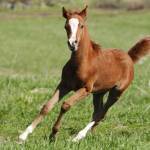Growing Horses: Energy, Protein, and Amino Acid Requirements

Energy, protein, and amino acid intake have the greatest impact on the growth and development of growing horses. For young horses, requirements for energy and protein, and consequently amino acids, are a function of the size of the animal (maintenance needs) and the rate at which the animal is growing. Conversely, the rate at which an animal grows is a function of how well the feeding program meets his energy and protein needs. If you want to maximize the growth rate of the animal, you must meet the animal’s energy and protein needs. If you want to restrict the growth rate of the animal, you can restrict energy or protein intake.
Energy is required for all body functions. However, energy is not a chemical that one can analyze for, but the result of the metabolic processing of substrates including glucose, fatty acids (both long chain and short chain) and the carbon chains of proteins not required for other functions. The factorial approach to determining the energy requirement of a growing animal involves finding the energy needs for maintenance and adding the energy required for growth (tissue energy deposition and efficiency of the conversion of dietary energy to tissue energy).
Protein requirements of the growing foal are a function of the amino acid requirements of the foal, the amino acid content of the feed ingredients, and the digestibility of those amino acids. The protein concentration required in the diet is a function of how well the available amino acid content of the diet matches the amino acid needs of the animal. Since the requirement of the animal can be divided into both a maintenance and a growth component, and since both energy and protein restriction will reduce growth of the animal, a constant relationship exists between energy and protein needs. These relationships exist only if the protein meets the amino acid needs of the animal, and may be in excess of the animal’s needs if the diet meets the amino acid needs with less protein.
Most of the data on the amino acid requirements of the growing horse have been derived from feeding trials that compare the growth of young horses on diets providing various concentrations of amino acids. Lysine was found to be the first limiting amino acid in most natural horse feeding programs, especially grass-based programs. This is because grasses and cereal grains tend to be quite low in lysine, requiring that the diet be supplemented with a more concentrated source of this amino acid. Soybean meal is the most likely source of higher lysine protein for horse feeds but animal protein products and a combination of other plant sources and lysine may also be used. Methionine, tryptophan, and threonine are all candidates as the second limiting amino acid in growing horses because they are limiting in other species. The data on methionine supplementation for growing horses are mixed. Some experiments show a growth response to methionine supplementation, some show a negative effect, and some no response at all. Tryptophan is generally higher in horse feeds than in diets for other nonruminant animals so it is not likely to be limiting. Threonine may very well be the second limiting amino acid in grass-based feeding programs for horses.








